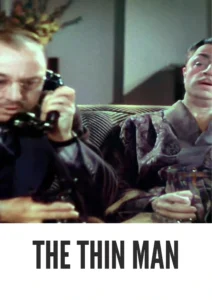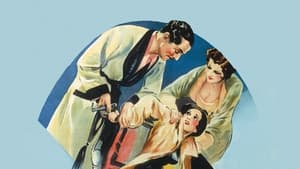Video Sources 0 Views
- Watch trailer
- The Thin Man 1934 Colorized


Synopsis
Table of Contents
ToggleCocktails, Crime, and Chemistry: The Thin Man (1934) in Dazzling Color

Dive into the glamorous world of 1930s New York with The Thin Man, a dazzling screwball mystery from 1934, now beautifully colorized for a viewing experience that pops! Starring William Powell and Myrna Loy, this film delivers a witty blend of sparkling banter, thrilling suspense, and undeniable chemistry. Perfect for fans of classic mysteries and sophisticated comedy, this HD download brings a beloved cinematic gem to vibrant new life.
The Thin Man Storyline: A Sophisticated Mystery Unfolds
The Thin Man follows the escapades of retired detective Nick Charles (William Powell) and his wealthy, vivacious wife, Nora (Myrna Loy), as they become embroiled in a perplexing murder case. While in New York for the holidays, Nick is drawn back into his old life when Dorothy Wynant seeks his help in finding her missing father, an eccentric inventor known as “The Thin Man.”As Nick and Nora investigate, they encounter a colorful cast of characters, including shady business partners, jealous ex-lovers, and suspicious family members. Their investigation is punctuated by witty banter, elegant parties, and plenty of cocktails. Despite the dangers, Nick and Nora approach the case with a playful spirit, turning the investigation into a stylish and entertaining adventure. The film culminates in a thrilling unmasking of the killer during a glamorous dinner party, showcasing the film’s perfect blend of mystery and humor. Ultimately, The Thin Man is a sophisticated and delightful film that celebrates the enduring appeal of wit, charm, and marital partnership.
Movie Cast
The film features a stellar cast of actors who bring this classic mystery to life:
- William Powell as Nick Charles
- Myrna Loy as Nora Charles
- Maureen O’Sullivan as Dorothy Wynant
- Nat Pendleton as Lt. John Guild
- Minna Gombell as Mimi Wynant Jorgenson
Movie Genre
The Thin Man falls into the genre of screwball mystery, blending elements of comedy, romance, and crime investigation. Its witty dialogue, charming characters, and sophisticated atmosphere make it a standout film of the 1930s.
Historical Context: The Golden Age of Hollywood
Released in 1934, The Thin Man represents the height of Hollywood’s Golden Age, showcasing the industry’s mastery of sophisticated storytelling, glamorous aesthetics, and star-studded performances. The film was produced during a time when audiences sought escapism and entertainment amidst the challenges of the Great Depression. The Thin Man not only became a box office success but also launched a successful film series, solidifying its place as a beloved classic of American cinema.
Colorization Details
This colorized version of The Thin Man has been meticulously restored using modern digital techniques, enhancing the visual appeal while preserving the film’s original charm and sophistication. The colorization process involved carefully analyzing the grayscale tones of the original black and white footage and assigning appropriate colors to each scene. This painstaking process brings new life to the characters and settings, making the story even more engaging for modern audiences. While some may debate the merits of colorizing classic films, it introduces these films to a broader audience, ensuring their legacy for future generations.
Technical Details
- Director: W.S. Van Dyke
- Screenplay: Albert Hackett, Frances Goodrich
- Based on: the novel by Dashiell Hammett
- Cinematography: James Wong Howe
- Edited by: Robert Kern
- Production Company: Metro-Goldwyn-Mayer
- Distributed by: Metro-Goldwyn-Mayer
- Runtime: 91 minutes
Technical Specifications
- Download Format: MP4
- Resolution: HD (1080p)
- Compatibility: Compatible with most devices, including smartphones, tablets, computers, and smart TVs.
Reviews and Critical Reception
The Thin Man (1934) is widely regarded as a classic of American cinema, praised for its witty dialogue, charming performances, and sophisticated blend of mystery and comedy. The film’s enduring appeal has solidified its place as a beloved favorite among classic film enthusiasts. As a sparkling example of Hollywood’s Golden Age, The Thin Man continues to delight audiences with its timeless charm and irresistible chemistry between its lead actors.
FAQs
- Q: What is The Thin Man about?
- A: The Thin Man is a screwball mystery about a retired detective and his wife who become embroiled in a murder case.
- Q: Is The Thin Man (1934) a well-known classic film?
- A: Yes, The Thin Man is a highly regarded classic film known for its witty dialogue, charming performances, and sophisticated blend of mystery and comedy.
- Q: Is this version of The Thin Man colorized?
- A: Yes, this version has been professionally colorized to enhance the viewing experience.
- Q: What makes The Thin Man so appealing?
- A: The Thin Man is appealing due to its witty dialogue, charming characters, and sophisticated blend of mystery and comedy, as well as the undeniable chemistry between William Powell and Myrna Loy.
- Q: What is the download format?
- A: The download format is MP4, which is compatible with most devices.
- Q: What resolution is the download?
- A: The resolution is HD (1080p), providing a high-quality viewing experience.
Download Now in HD!
Watch The Thin Man Today!




















